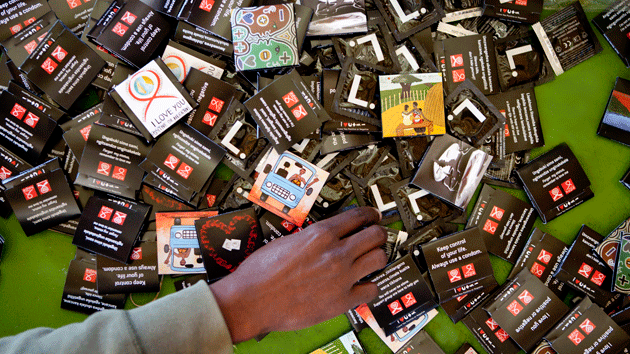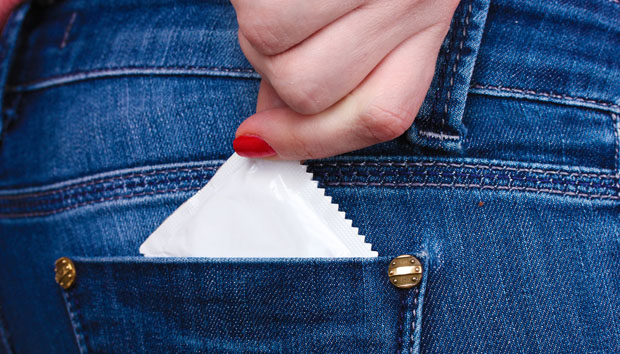
Some of L.'s condoms, which are packaged by HIV-positive women in Swaziland.Image courtesy of Talia Frenkel
During her time documenting natural disasters as a Red Cross photojournalist, Talia Frenkel saw first-hand the devastating effects of HIV and AIDS in Africa. She wanted to help combat this preventable disease, so in 2010, she created a women’s health company with a mission: For every L. Condom purchased in the United States, the company donates one condom to a person in the developing world. L. also employs HIV-positive women in Swaziland—they package the condoms. Meanwhile, business in the United States is booming: L. has rolled out bike delivery service in San Francisco, Los Angeles and Manhattan. Next up: an app that offers foreplay tips while you wait for your condoms to arrive, and expanding into other women’s healthcare products. I spoke with Frenkel about weird condom additives, being perceived as “shady” because of her job, and how L. distributes condoms to women who need them most.
Mother Jones: What’s the most surprising thing that you’ve learned working in the condom business?

Talia Frenkel: Most packaged consumer goods companies are actually owned by men, so there are very few women who are involved in the manufacturing and branding of products that women are predominantly purchasing. I think there’s something really broken about that, when women aren’t being included in the thought process. And the condom industry even more so, right? Me going into the manufacturing facility, I’m like “I’m the CEO, I promise!” It was really hard to be taken seriously at first.
MJ: Would you say that was one of the biggest challenges of starting the company? Being a woman?
TF: You tell someone you own a women’s health company and they ask what your product is and you say, “Oh, it’s condoms.” They look at you like you’re a porn star or something. This is a basic woman’s health product that I think every woman should have in her purse. It’s not taboo to carry a birth control pill case, but it is with a condom, so I don’t understand why we act like condoms cause promiscuity. Condoms don’t cause promiscuity anymore than umbrellas cause it to rain.
MJ: How did you come up with the idea of one-hour condom delivery via bike messengers?
TF: Condom aisles can be uncomfortable, [especially when] condoms can be behind glass and key. It’s like you have to make an announcement to the entire store, “Aisle 6, I’m having sex!” They’re not always that easily accessible. We started talking to these messenger groups, and the bike messengers themselves are really ecstatic about it. They like knowing that what they’re doing is involved with a cause. It truly is in line with our values of sustainability by having a low carbon footprint.
MJ: Why is it important to have environmentally friendly and chemical-free condoms?
TF: Our shampoos and conditioners have “paraben-free” on them but our condoms don’t. It’s just crazy. A lot of people have really negative experiences with condoms not knowing why. When you look at it, the complaints about condoms are they smell bad, they taste disgusting, they dry out, they’re physically irritating. All of these issues can actually be addressed in the materials that are being sourced, and then in the manufacturing process. If you look at an L. condom it’s a lot clearer than other products, and has a lower latex odor and taste. We made sure that the products are glycerin- and paraben-free, and don’t contain any potentially harmful additives.
MJ: What makes latex sustainable?
TF: Condoms are typically made from polyurethane or natural rubber latex. Polyurethane is a plastic so it has the environmental issues that all plastics have. But natural latex doesn’t have those issues.
MJ: How do you make sure your condoms get to the people who need them most?
TF: [The international development NGO] BRAC is one of my favorite organizations because it employs so many women on the ground. They train women as health care providers and they educate them, and they teach them how to teach their peers about basic health products. And then these women go out from community to community, and they sell products like condoms at the low market cost. By doing that, they are making a living wage for themselves, they become breadwinners in their families and their communities, and they have more of a say in making decisions, such as negotiating condom use.
MJ: The one-for-one model has its critics: Some people say that well-meaning businesses don’t do their research about what people in the developing world actually need.
TF: Every community needs access to contraception, and in Africa this is the most basic tool for fighting the HIV epidemic. Something that was important for me coming into this was speaking to the local program officers, asking them where their needs were, and telling them we’re not coming in and dropping off our product without communication. For example, in Swaziland they wanted a new condom because they had tried different condoms and weren’t happy with the brands they were distributing, so they wanted to try L. They also wanted the packaging and art from HIV-positive women to help with removing the stigma. But in Uganda, they said “we’ve been socially marketing a product, we’ve had good momentum and progress, we don’t want to start distributing a new brand of condoms right now.” I said okay, tell me which brand you want to distribute, let’s identify it, and we’ll support the purchase of that product. We’re not Coca-Cola here trying to get our brand into Africa. We’re here to support their work. We’re not disrupting the local condom seller.
MJ: Have you encountered any type of resistance in the countries where you distribute condoms? Is any part of your distributing condoms perceived as controversial?
TF: We’ve obviously encountered some of the stigma and taboo, hearing comments like using a condom is eating candy with the wrapper on. You also hear things like that in America. We talk about how we can overcome those barriers to condom usage, but for the most part we’ve been really overwhelmed with how incredible these programs have been, and how eager the women are to educate their peers. That has been inspiring and humbling.











